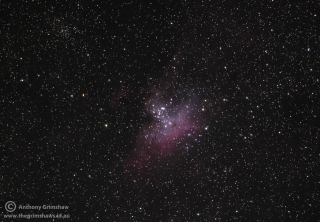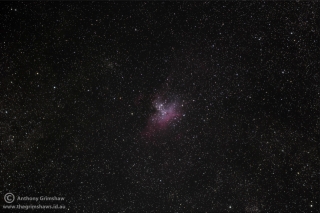M16 Eagle Nebula
This months BAS Club event was a particularly good event with a great turn out of both BAS and SEQAS members it was almost difficult to find a patch of dirt to set up on :). This time around and given it was such a good evening I had several targets in mind and some I was told about while I was there.
This image was taken on Saturday 20th May 2012, at around 11:00 PM in Hazeldean QLD, Australia. The seeing conditions were about an 8.5/10 as there was a lot still some moisture in the air and the light pollution from Brisbane was still very visible. There was a forecast for rain so we were still quite lucky.
I used my Canon EOS 600D DSLR to take the image and the exposure times were as follows:
- 300 Seconds at ISO 200 * 1 Frame (Not used in final Image)
- 600 Seconds at ISO 400 * 5 Frames
- 600 Seconds at ISO 800 * 2 Frames
I still have a problem with my guiding as it get slightly egg shaped stars but it was not as bad as the April Club event so I could push on through with more images and make the most of the evening, I must get to the bottom of this new problem, i think it is either the clutch on the RA Axis of my mount or some flexing in the cross bar I am using? I will do some testing in the back yard.
For processing the image I used Deep Sky Stacker, I didn’t use any Darks, Flats or Bias frames in the stacking process, after the images were stacked I adjusted the levels slightly, saved it and uploaded for viewing.
A little more info about the Nebula you can see in the image:
- Name: Messier 16 or M16
- Type: Emission Nebula
- Magnitude: 6.4
- Constellation: Serpens
- Distance: 6500 Light Years
- Other Designations: NGC 6611, Eagle Nebula (IC 4703)
M16 (NGC 6611) was first discovered by Philippe Loys de Chéseaux in 1745-6, however it was Charles Messier who was the very first to see and document the nebulosity associated with it. It is believed to be located in the next inner spiral arm of the Milky Way. M16 spans some 70 by 50 light years across and caught in its heart is cluster of stars that were born around 5.5 million years ago. The actual Eagle you see is also commonly known as the “Pillars of Creation”.
The Pillars of Creation is an active star forming region of dense gas, the longest pillar of gas is approximately 7 Light Years tall. As with all emission nebula the clouds of dust are illuminated by the emission of radiation from the surrounding stars. You can read more about this fascinating region of space here: Pillars of Creation.
I hope you enjoy my images of the Eagle :), one is a full frame the other is a cropped version of the same image.

